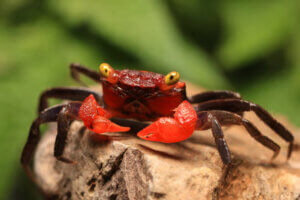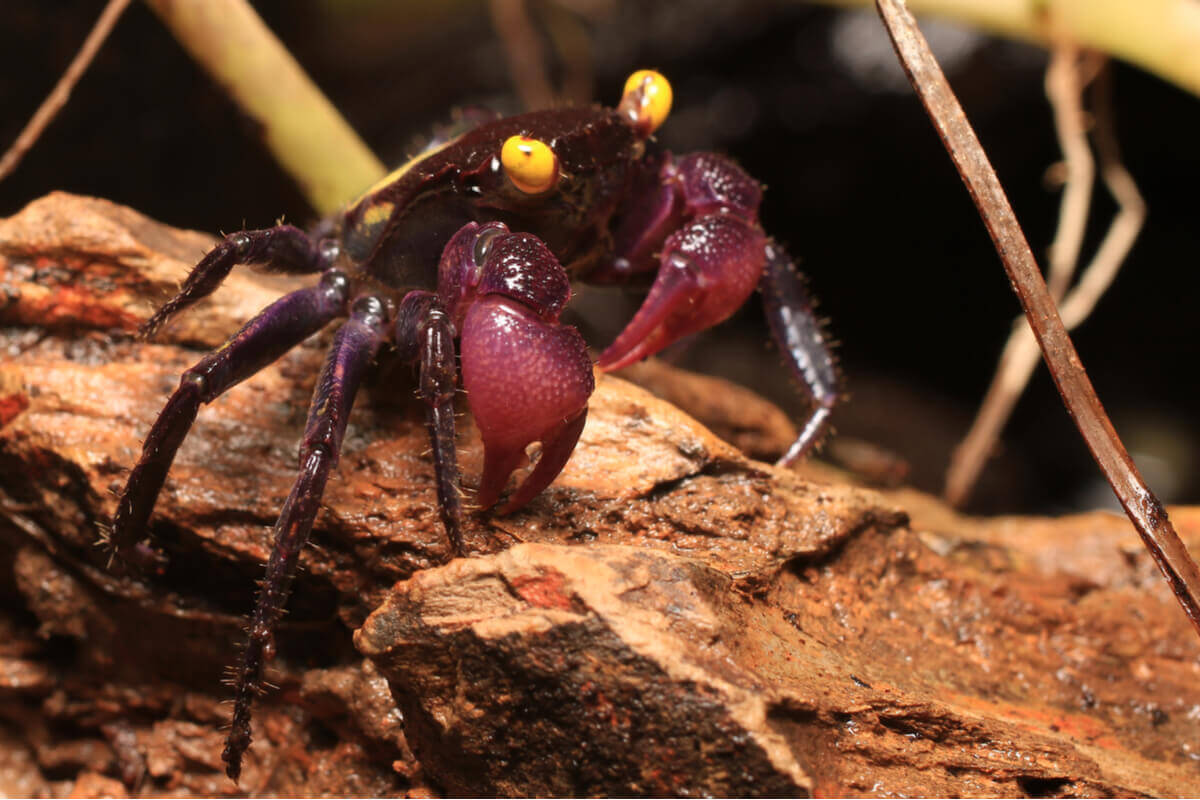Keeping a Vampire Crab as a Pet

It might seem strange, but crabs are becoming increasingly popular exotic pets. One particularly popular species is the vampire crab because of its rather striking habits.
This freshwater crab belongs to the genus Geosesarma, which is native to Malaysia and Indonesia and includes 59 different species. The vampire crab is a small but very colorful invertebrate, which is just one reason why they’re so popular. If you’re thinking of keeping one as a pet, read on to find out everything you need to know!
The vampire crab and other geosesarma species
These species are quite small, measuring between 2 and 3 inches, and they’re very colorful. They often have colorful dark and fiery red bodies, and their claws can be a range of colors, such as yellow, orange, purple, and blue. Vampire crabs are usually black and dark red.
Just like other crabs, these species also exhibit some sexual dimorphism. The males have larger claws, for example. On the other hand, the females have a larger, curved abdomen while the males’ abdomen is narrower and more of a pyramid shape.

Caring for Geosesarma crabs
Geosesarma crabs live on the banks of streams and they need fresh water and a humid environment to survive. Luckily, they’re calm animals and easy to keep as pets, although they’re usually quite wary of humans.
These species have not been evaluated by the International Union for the Conservation of Nature (IUCN). As a result, they’re not included in the Washington Convention (CITES) – a multilateral treaty to protect endangered plants and animals.
If you’re looking for an exotic pet, only ever go to a trusted seller who sells animals bred in captivity. Furthermore, these animals should never be released into the wild. While they might seem fairly insignificant creatures, they could have a serious impact on the local ecosystem.
So, if you’re seriously thinking about getting a vampire crab, let’s look at some other things you need to consider first.
What should the terrarium be like?
If you’re keeping a couple of crabs, an enclosure measuring about 8 x 8 x 8 inches should be enough. But obviously, this should be bigger if you’re thinking about getting more crabs in the future. Bear in mind that the males are territorial and they can fight if there isn’t enough space or food.
You need to do all you can to replicate the humidity and temperature of their natural environment. The terrarium should also have a terrestrial section and an aquatic section. These types of enclosures are sometimes called paludariums.
You could submerge some soil on one side to try and imitate the bank of a stream. Then, on the other side, you could keep things drier and have some rocks, logs, and other hiding places.
The aquatic part of this enclosure is really important, as this is where they’ll molt or spawn. But for the land side of the paludarium, you’ll also need to choose a substrate that retains moisture and which they can burrow in. Something like coconut fiber or peat is ideal.
Finally, as mentioned, put some hiding places in there, especially if you’re going to keep more than one. You might want to also add some different aquatic plants like floating plants, algae, or moss.
Environmental conditions
Firstly, you’ll need to keep the humidity at around 80-100% and the temperature between 75 and 82 °F during the day. This can drop to between 68 and 75 °F at night. Vampire crabs are nocturnal, so you’ll need to carefully control the temperature and the photoperiod, which should be 12 hours.
- You can achieve a tropical temperature by placing a heated blanket on one side of the enclosure on the outside of the glass.
- The evaporating water will help maintain the humidity levels, but you should still spray the land area a couple of times a day. The substrate should always be moist to the touch, but not soggy.
What does the vampire crab eat?
Geosesarma crabs are hunters, so you’ll need to give them live insects like fruit flies, small snails, springtails, mealybugs, silverfish, earthworms, and small crickets. But they’re also omnivorous, so they’ll also eat dead animals, fruit, vegetables, and fish food.
Finally, these crabs need calcium and iodine to be able to successfully molt or change their exoskeleton. You can ensure this by adding a cuttlefish skeleton to their terrarium, for example. Or alternatively, you could buy some special supplements and sprinkle them over their food.
Breeding vampire crabs
If you have both male and female vampire crabs, breeding will be fairly straightforward. But the females will need water to spawn in. After mating, the females usually release about 50 to 60 eggs at a time.
Young crabs look darker and much smaller than adults. To feed them, you can offer them fruit flies, brine shrimp, springtails, fish food pellets, or even small pieces of fish.

As you can see, keeping a vampire crab is a bit like keeping a fish or amphibian, but they’re nowhere near as demanding. With relatively little work, you’ll be able to enjoy a calm, yet active and fascinating exotic pet.
It might seem strange, but crabs are becoming increasingly popular exotic pets. One particularly popular species is the vampire crab because of its rather striking habits.
This freshwater crab belongs to the genus Geosesarma, which is native to Malaysia and Indonesia and includes 59 different species. The vampire crab is a small but very colorful invertebrate, which is just one reason why they’re so popular. If you’re thinking of keeping one as a pet, read on to find out everything you need to know!
The vampire crab and other geosesarma species
These species are quite small, measuring between 2 and 3 inches, and they’re very colorful. They often have colorful dark and fiery red bodies, and their claws can be a range of colors, such as yellow, orange, purple, and blue. Vampire crabs are usually black and dark red.
Just like other crabs, these species also exhibit some sexual dimorphism. The males have larger claws, for example. On the other hand, the females have a larger, curved abdomen while the males’ abdomen is narrower and more of a pyramid shape.

Caring for Geosesarma crabs
Geosesarma crabs live on the banks of streams and they need fresh water and a humid environment to survive. Luckily, they’re calm animals and easy to keep as pets, although they’re usually quite wary of humans.
These species have not been evaluated by the International Union for the Conservation of Nature (IUCN). As a result, they’re not included in the Washington Convention (CITES) – a multilateral treaty to protect endangered plants and animals.
If you’re looking for an exotic pet, only ever go to a trusted seller who sells animals bred in captivity. Furthermore, these animals should never be released into the wild. While they might seem fairly insignificant creatures, they could have a serious impact on the local ecosystem.
So, if you’re seriously thinking about getting a vampire crab, let’s look at some other things you need to consider first.
What should the terrarium be like?
If you’re keeping a couple of crabs, an enclosure measuring about 8 x 8 x 8 inches should be enough. But obviously, this should be bigger if you’re thinking about getting more crabs in the future. Bear in mind that the males are territorial and they can fight if there isn’t enough space or food.
You need to do all you can to replicate the humidity and temperature of their natural environment. The terrarium should also have a terrestrial section and an aquatic section. These types of enclosures are sometimes called paludariums.
You could submerge some soil on one side to try and imitate the bank of a stream. Then, on the other side, you could keep things drier and have some rocks, logs, and other hiding places.
The aquatic part of this enclosure is really important, as this is where they’ll molt or spawn. But for the land side of the paludarium, you’ll also need to choose a substrate that retains moisture and which they can burrow in. Something like coconut fiber or peat is ideal.
Finally, as mentioned, put some hiding places in there, especially if you’re going to keep more than one. You might want to also add some different aquatic plants like floating plants, algae, or moss.
Environmental conditions
Firstly, you’ll need to keep the humidity at around 80-100% and the temperature between 75 and 82 °F during the day. This can drop to between 68 and 75 °F at night. Vampire crabs are nocturnal, so you’ll need to carefully control the temperature and the photoperiod, which should be 12 hours.
- You can achieve a tropical temperature by placing a heated blanket on one side of the enclosure on the outside of the glass.
- The evaporating water will help maintain the humidity levels, but you should still spray the land area a couple of times a day. The substrate should always be moist to the touch, but not soggy.
What does the vampire crab eat?
Geosesarma crabs are hunters, so you’ll need to give them live insects like fruit flies, small snails, springtails, mealybugs, silverfish, earthworms, and small crickets. But they’re also omnivorous, so they’ll also eat dead animals, fruit, vegetables, and fish food.
Finally, these crabs need calcium and iodine to be able to successfully molt or change their exoskeleton. You can ensure this by adding a cuttlefish skeleton to their terrarium, for example. Or alternatively, you could buy some special supplements and sprinkle them over their food.
Breeding vampire crabs
If you have both male and female vampire crabs, breeding will be fairly straightforward. But the females will need water to spawn in. After mating, the females usually release about 50 to 60 eggs at a time.
Young crabs look darker and much smaller than adults. To feed them, you can offer them fruit flies, brine shrimp, springtails, fish food pellets, or even small pieces of fish.

As you can see, keeping a vampire crab is a bit like keeping a fish or amphibian, but they’re nowhere near as demanding. With relatively little work, you’ll be able to enjoy a calm, yet active and fascinating exotic pet.
All cited sources were thoroughly reviewed by our team to ensure their quality, reliability, currency, and validity. The bibliography of this article was considered reliable and of academic or scientific accuracy.
- D.N.A.T ecosistemas
- Zoolo exóticos. Geosesarma spp. (Cangrejos vampiros). Recogido a 17 de enero en https://zooloexoticos.wordpress.com/2017/05/12/geosesarma-sp-cangrejos-vampiros/
- laventanaverde. Conociendo a los cangrejos Geosesarma
This text is provided for informational purposes only and does not replace consultation with a professional. If in doubt, consult your specialist.








